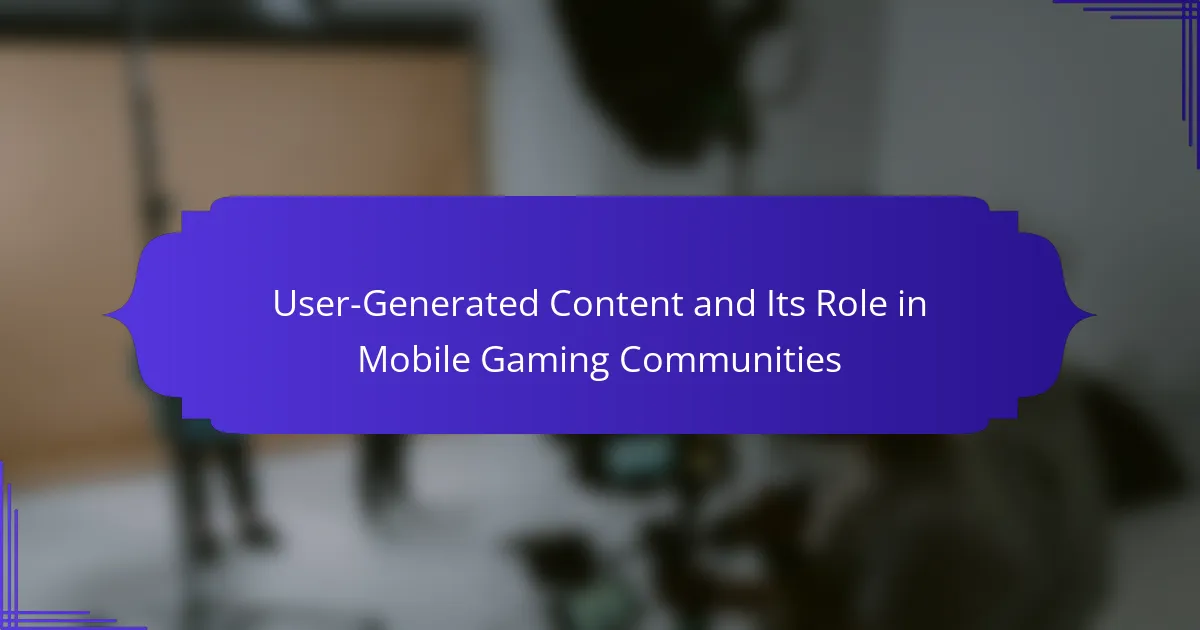User-generated content plays a crucial role in enhancing engagement within mobile gaming communities. It fosters creativity and collaboration, allowing players to contribute fan art, gameplay videos, and mods. Developers face challenges in moderation and copyright management. Trends vary by region, reflecting cultural preferences and technological access, while tools and resources facilitate community interaction.
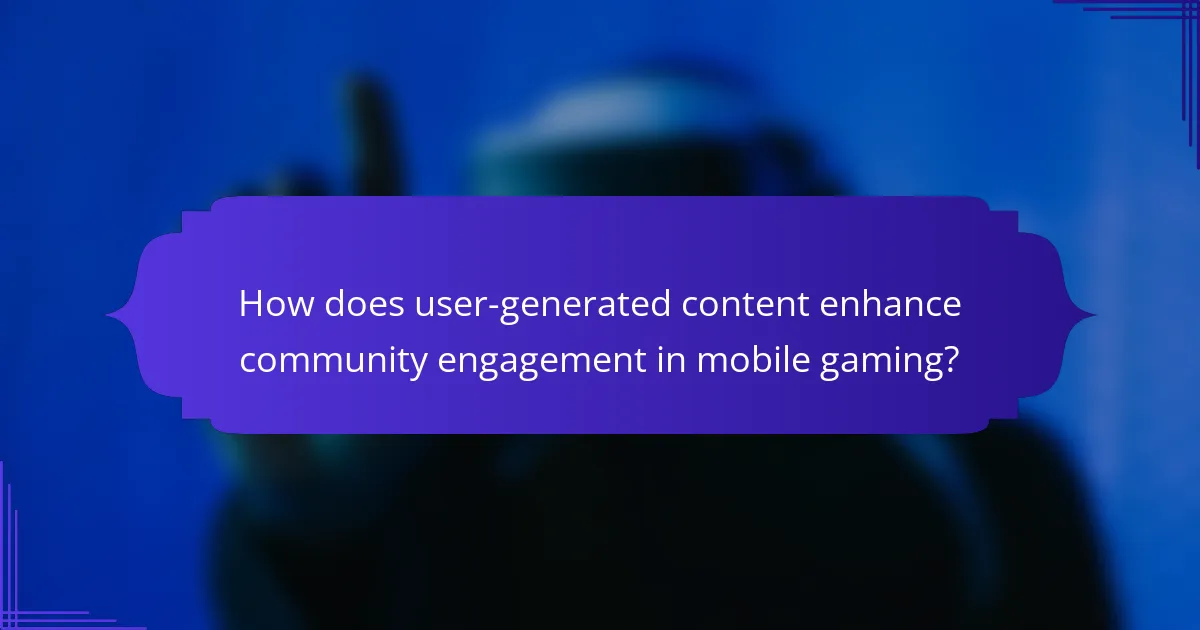
How does user-generated content enhance community engagement in mobile gaming?
User-generated content significantly enhances community engagement in mobile gaming by fostering creativity and collaboration. Players contribute their own creations, which strengthens social bonds and encourages interaction. This active participation leads to a sense of ownership and belonging within the gaming community. Additionally, user-generated content can provide fresh experiences, keeping the gameplay dynamic and exciting. As a result, mobile games that incorporate user-generated content often see increased player retention and satisfaction.
What motivates players to create content for mobile games?
Players are motivated to create content for mobile games due to community engagement, personal expression, and potential recognition. Engaging with a game’s community fosters a sense of belonging, while personal expression allows players to showcase creativity. Recognition from peers or developers can enhance motivation further. Additionally, user-generated content can influence game development, providing feedback that shapes future updates. This collaborative environment enriches the gaming experience, driving players to contribute actively.
Which platforms are most popular for sharing user-generated content?
The most popular platforms for sharing user-generated content in mobile gaming communities are social media sites, forums, and dedicated gaming platforms. These include platforms like Instagram, YouTube, Reddit, and Discord. Each platform offers unique features that enhance community interaction and content sharing. For example, Instagram allows for visual storytelling, while YouTube supports video content creation and tutorials.
How does user-generated content influence player retention and loyalty?
User-generated content significantly enhances player retention and loyalty in mobile gaming communities. Engaging with user-created content fosters a sense of belonging and community. Players who contribute or interact with such content feel more invested in the game, leading to longer play sessions and increased loyalty.
Moreover, user-generated content often drives organic marketing, as players share their experiences, attracting new users. This cycle of engagement reinforces a player’s commitment to the game, as they witness the impact of their contributions. Studies show that games with robust user-generated content platforms report higher retention rates, highlighting its essential role in modern gaming ecosystems.
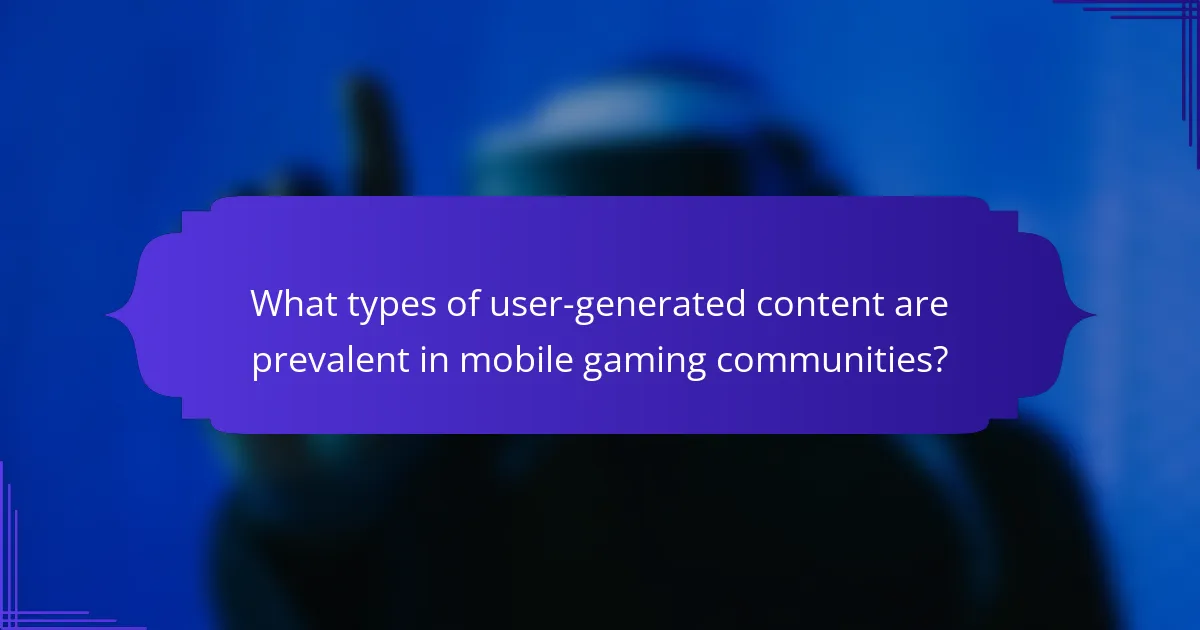
What types of user-generated content are prevalent in mobile gaming communities?
User-generated content in mobile gaming communities includes fan art, gameplay videos, mods, and reviews. These types enhance engagement and foster community interaction. Fan art showcases creativity, while gameplay videos provide tips and entertainment. Mods allow players to customize their experiences, and reviews help inform potential players. Each type contributes uniquely to the gaming ecosystem, enriching player involvement and community growth.
How do mods and custom levels impact gameplay experience?
Mods and custom levels significantly enhance gameplay experience by offering unique challenges and creative expression. They foster community engagement and extend the game’s lifespan. User-generated content allows players to explore diverse gameplay styles, ultimately enriching the overall gaming experience. Custom levels can introduce innovative mechanics, while mods may enhance graphics or alter game dynamics, appealing to varied player preferences. This diversity in gameplay leads to increased player retention and satisfaction, highlighting the vital role of user-generated content in mobile gaming communities.
What role do fan art and storytelling play in community culture?
Fan art and storytelling significantly enrich community culture in mobile gaming. They foster creativity, strengthen bonds among players, and enhance engagement with the game world. User-generated content allows fans to express their interpretations, leading to a diverse range of narratives and artistic styles. This interaction cultivates a sense of belonging and shared experience, as players connect over their creations. Additionally, fan art often serves as a bridge between developers and the community, influencing future game content and updates.
Which forms of user-generated content are most effective for marketing mobile games?
User-generated content that showcases gameplay, fan art, and community challenges is most effective for marketing mobile games. These forms foster engagement and build community. Gameplay videos attract attention, while fan art enhances brand loyalty. Community challenges encourage participation and create a sense of belonging. Together, they drive user acquisition and retention.
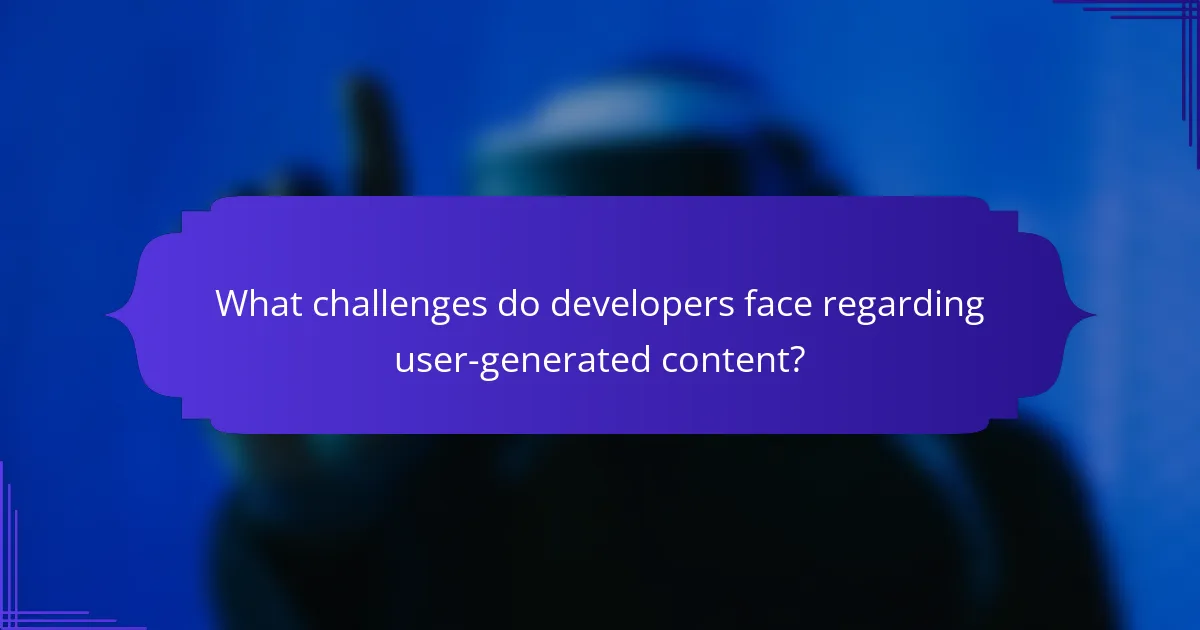
What challenges do developers face regarding user-generated content?
Developers face several challenges with user-generated content in mobile gaming communities. Key issues include moderation difficulties, ensuring content quality, managing copyright concerns, and maintaining community engagement.
Moderation is essential to prevent harmful or inappropriate content, which can deter users. Developers must implement effective systems for filtering and reviewing submissions. Ensuring content quality is another challenge, as low-quality contributions can diminish the overall gaming experience.
Copyright concerns arise when users create content that may infringe on intellectual property rights. Developers need clear guidelines to protect their brands while encouraging creativity. Lastly, maintaining community engagement is crucial; developers must foster a positive environment that motivates users to contribute meaningfully.
How do copyright issues affect user-generated content in mobile games?
Copyright issues significantly limit user-generated content in mobile games. These legal constraints can lead to the removal of user creations, impacting community engagement. Game developers often enforce copyright to protect their intellectual property, which can discourage players from sharing their content. As a result, the balance between creativity and legal compliance is crucial for fostering vibrant gaming communities.
What are the risks of inappropriate content in gaming communities?
Inappropriate content in gaming communities poses serious risks, including toxicity, harassment, and alienation of users. Such content can create a hostile environment, leading to decreased user engagement and community fragmentation.
Moreover, exposure to inappropriate content can negatively impact mental health, particularly among younger players. This can result in increased anxiety and depression, affecting their overall gaming experience.
Additionally, inappropriate content can damage a game’s reputation, leading to potential loss of revenue. Developers may face backlash from players and parents, resulting in stricter content regulations and oversight.
Lastly, inappropriate content can foster a culture of exclusion, where marginalized groups feel unwelcome. This not only affects community dynamics but also limits the diversity and creativity within gaming spaces.
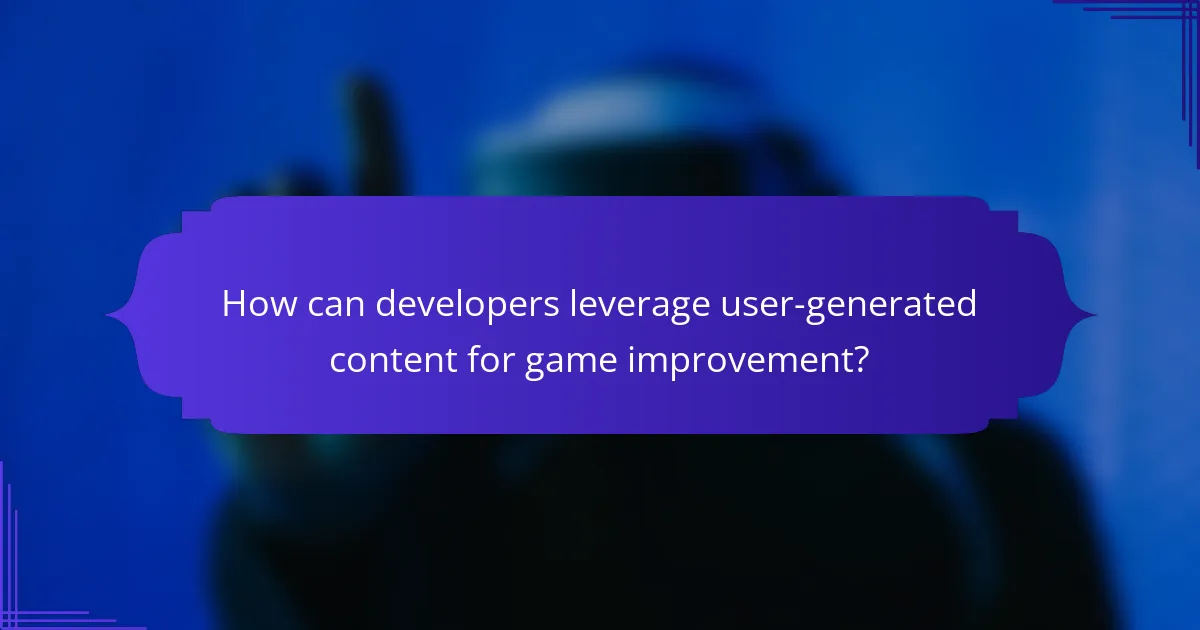
How can developers leverage user-generated content for game improvement?
Developers can enhance game quality by integrating user-generated content. This approach fosters community engagement and provides valuable insights for improvements.
User-generated content offers a wealth of feedback and creative ideas. Developers can analyze player submissions to identify popular features and gameplay mechanics. This data helps prioritize updates and new content that aligns with player preferences.
Encouraging user participation through contests or feedback loops can increase content diversity. Developers can implement systems that reward players for contributions, fostering a sense of ownership and loyalty within the gaming community.
Utilizing user-generated content also aids in identifying bugs or balancing issues. Players often highlight problems that may go unnoticed by developers, leading to faster resolutions and improved gaming experiences.
What strategies can be employed to encourage positive contributions from players?
Encouraging positive contributions from players involves creating an inclusive environment and incentivizing engagement. Implementing clear guidelines fosters respect and creativity. Reward systems, such as in-game bonuses or recognition, motivate players to contribute. Regular feedback and community events enhance collaboration and build a sense of belonging.
How can user feedback through content shape future game updates?
User feedback through content significantly influences future game updates by providing developers with direct insights into player preferences and experiences. This feedback allows for targeted improvements, ensuring updates align with community expectations.
Developers often analyze user-generated content to identify popular features and areas needing enhancement. For instance, community suggestions can lead to the introduction of new gameplay mechanics or adjustments to existing ones, enhancing overall user satisfaction.
Additionally, feedback can highlight bugs or balance issues, prompting quicker resolutions. Engaging with the community fosters a sense of ownership, encouraging players to contribute more actively, which in turn informs ongoing development.
In summary, user feedback acts as a vital resource for shaping mobile game updates, driving innovation and improving player retention.
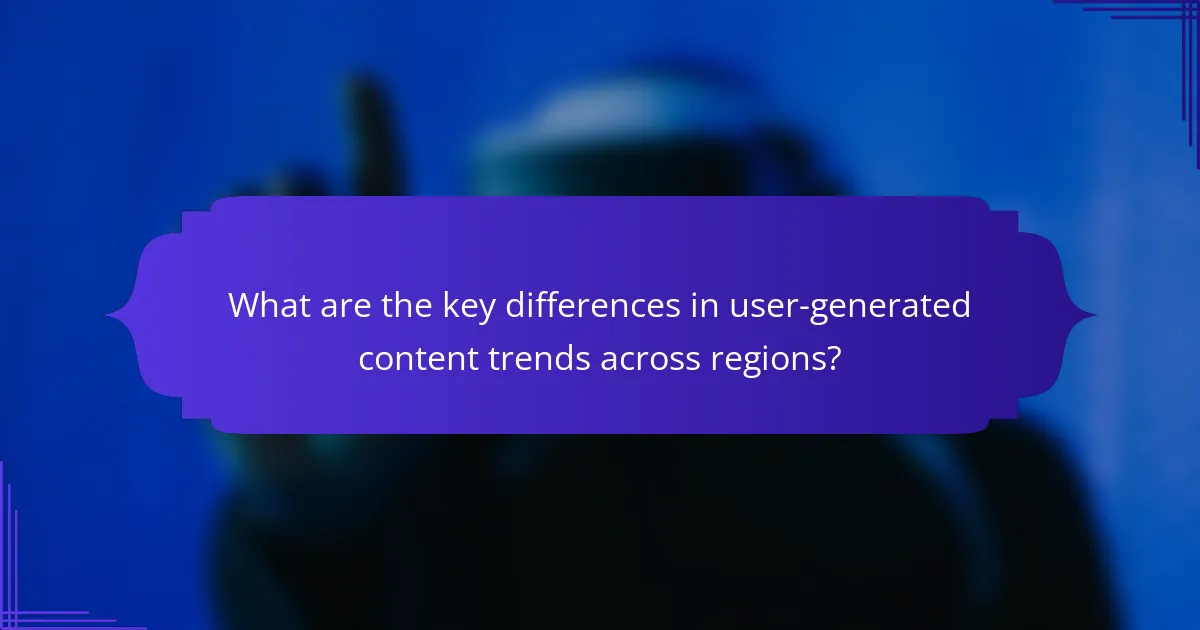
What are the key differences in user-generated content trends across regions?
User-generated content trends vary significantly across regions due to cultural preferences and technological access. In North America, user-generated content focuses on authenticity and community engagement, while in Asia, the emphasis is on visual storytelling and mobile integration. Europe tends to prioritize privacy and quality, influencing how content is created and shared. Additionally, regions like Latin America showcase vibrant, informal content styles that foster connection. These differences highlight the unique attributes of user engagement in mobile gaming communities worldwide.
How do cultural influences shape the types of content created in gaming communities?
Cultural influences shape content in gaming communities by reflecting shared values and experiences. These influences determine the themes, narratives, and aesthetics that resonate with players. For instance, regional folklore often inspires game design, leading to unique user-generated content. Additionally, cultural trends and social movements can prompt community engagement, fostering creativity and collaboration. This dynamic interaction enriches the gaming experience, making it more relatable and engaging for diverse audiences.
What regional platforms are preferred for sharing user-generated content?
Mobile gaming communities prefer platforms like Discord, Reddit, and Twitch for sharing user-generated content. These platforms foster interaction and creativity among users, enhancing the gaming experience. Discord offers real-time communication, while Reddit provides structured discussions. Twitch enables live streaming, allowing gamers to share gameplay and engage with viewers instantly.
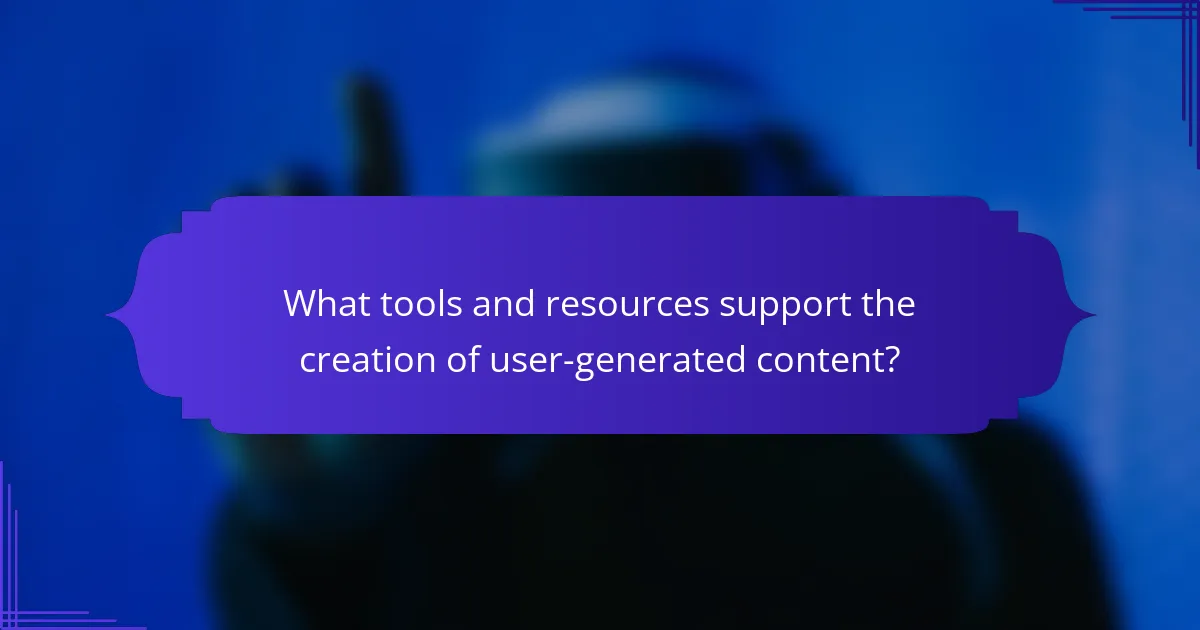
What tools and resources support the creation of user-generated content?
User-generated content in mobile gaming communities is supported by various tools and resources. Social media platforms enable easy sharing and engagement. Game development software allows players to create levels and mods. Forums and community sites facilitate discussions and feedback. Streaming services provide a platform for sharing gameplay experiences. Additionally, content creation tools enhance creativity, enabling players to produce videos, artwork, and guides. These resources foster collaboration and strengthen community bonds.
Which software is most popular among creators for designing game mods?
The most popular software among creators for designing game mods includes Unity, Unreal Engine, and ModLoader. These platforms offer extensive tools and community support for user-generated content. Unity is favored for its versatility and user-friendly interface, while Unreal Engine excels in graphics quality. ModLoader simplifies the modding process for various games, enhancing accessibility for creators.
How can game developers provide resources to assist content creators?
Game developers can support content creators by providing comprehensive resources that enhance user-generated content. These resources include development tools, documentation, and community engagement platforms.
1. Development Tools: Offering software development kits (SDKs) and application programming interfaces (APIs) enables creators to build and integrate content seamlessly into games.
2. Documentation: Clear guidelines and tutorials help creators understand the mechanics of the game, ensuring high-quality content production.
3. Community Platforms: Establishing forums or social media groups fosters collaboration and sharing among creators, enhancing the overall gaming experience.
4. Incentives: Providing rewards or recognition for outstanding user-generated content encourages more creators to participate actively.
These strategies collectively strengthen the relationship between developers and content creators, enriching mobile gaming communities.
What best practices should content creators follow to ensure quality and engagement?
Content creators should prioritize authenticity, community engagement, and quality in user-generated content for mobile gaming communities. Encouraging players to share experiences fosters a sense of belonging.
1. Establish clear guidelines for submissions to ensure quality and relevance.
2. Regularly feature user content to promote engagement and recognition.
3. Respond to user contributions to create a dialogue and enhance community ties.
4. Utilize analytics to understand what content resonates most with the audience.
These practices lead to a vibrant community, enhancing overall user experience and retention.
What common mistakes do creators make when producing content for mobile games?
Creators often overlook user engagement and community feedback when producing content for mobile games. Ignoring these elements can lead to a disconnect between the game and its audience.
Common mistakes include underestimating the importance of user-generated content, which enhances community interaction and retention. Failing to optimize for mobile interfaces can also hinder user experience, as many creators neglect responsive design principles.
Additionally, overlooking the significance of regular updates and content refreshment can result in player disengagement, as players seek new experiences. Lastly, not analyzing player data and feedback limits the ability to tailor content effectively to user preferences.
